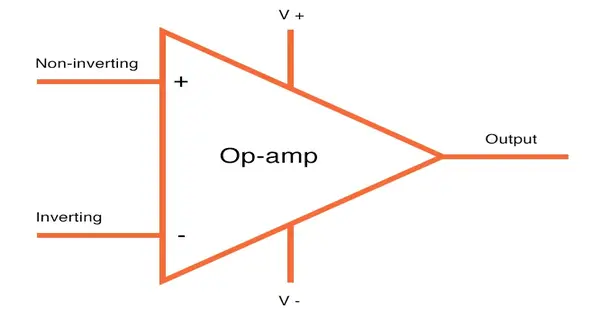An operational amplifier (abbreviated op amp or opamp) is a high-gain, DC-coupled electronic voltage amplifier with a differential input and, in most cases, a single-ended output. An op amp produces an output potential (relative to circuit ground) that is typically 100,000 times greater than the potential difference between its input terminals in this configuration. The operational amplifier derives its name and origins from analog computers, where it was used to perform mathematical operations in linear, nonlinear, and frequency-dependent circuits.
The op-amp typically has two input terminals, inverting (-) and non-inverting (+), as well as one output terminal. In most cases, the inverting input is denoted by a minus sign (“-“), while the non-inverting input is denoted by a plus sign (“+”). Based on its amplification factor or gain, the op-amp amplifies the voltage difference between these inputs and produces an output voltage.
Op-amps are typically built with a high gain, a high input impedance (resistance), a low output impedance, and a low distortion. They are frequently used with negative feedback, in which a portion of the output voltage is fed back to the inverting input to stabilize and control the characteristics of the amplifier.
The op amp’s popularity as a building block in analog circuits stems from its versatility. The characteristics of an op-amp circuit, such as gain, input and output impedance, bandwidth, and so on, are determined by external components and have little dependence on temperature coefficients or engineering tolerance in the op amp itself when negative feedback is used.
The basic symbol for an op-amp is a triangle with the amplifier’s inputs and outputs indicated. The power supply connections, which provide the op-amp with the necessary operating voltage, are also shown.
Op-amps can be driven by single or dual power supplies. Single-supply op-amps use a positive power supply and ground as the reference point, whereas dual-supply op-amps use both positive and negative power supplies, with ground as the reference point.
Some common characteristics and parameters of op-amps include:
- Gain: The amplification factor of the op-amp, which determines how much the input voltage is multiplied to produce the output voltage.
- Input and Output Impedance: The resistance seen by the input and output terminals of the op-amp. High input impedance ensures minimal loading of the input signal source, while low output impedance helps to drive loads efficiently.
- Bandwidth: The range of frequencies over which the op-amp can provide its specified gain. It is determined by the internal circuitry and external components used.
- Slew Rate: The maximum rate of change of the output voltage. It indicates how fast the op-amp can respond to changes in the input signal.
- Common Mode Rejection Ratio (CMRR): A measure of how well the op-amp rejects any signals that are common to both inputs (common-mode signals) and only amplifies the difference between the inputs.
Inverting amplifiers, non-inverting amplifiers, differential amplifiers, integrators, differentiators, and other types of op-amps are available. External resistors, capacitors, and other components are connected to the op-amp’s inputs and outputs to achieve these configurations.















